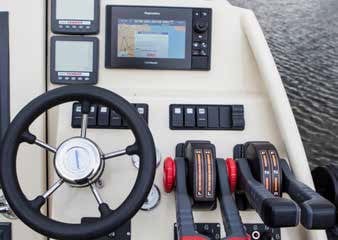AMSTERDAM _ In 2014, in Australia, RIBs builder Bruno Tideman became a believer in High Density Polyethylene work boats. Today, he makes 20 a year and sold one recently as a tender for a 44m (144 ft.) superyacht. Oops, that was a fluke. The yachting sector is not Tideman’s natural habitat and he is looking for marketing help.
Any takers out there? Keep reading!
HDPE is a super tough thermoplastic with a high strength-to-density ratio, mostly used for plastic bottles and piping. Tideman says it is ideal for his clients _ “people in steel-toed boots who toss anchors about.” Tideman Rigid Buoyancy Boats _ crew tenders, survey and patrol craft, dive boats etc. _ are built for rough conditions and sold to clients from West Africa to Europe to Kazakhstan.
With the growing popularity of explorer and expedition yachts, Tideman sees a niche. He believes yacht owners heading into arctic waters or to remote Pacific Ocean islands will gladly set aside esthetics and embrace HDPE’s practical advantages.
 “The owner of the 44m yacht said our type of work boat is exactly what he wanted,” he tells Dutch Yacht Building. “His RIBs were constantly damaged by hitting rocks during dive trips.” The diving tender he sold the yacht owner has 2 showers, a small cabin with a berth, a wash basin and toilet and a top speed of 40 knots.
“The owner of the 44m yacht said our type of work boat is exactly what he wanted,” he tells Dutch Yacht Building. “His RIBs were constantly damaged by hitting rocks during dive trips.” The diving tender he sold the yacht owner has 2 showers, a small cabin with a berth, a wash basin and toilet and a top speed of 40 knots.
Tideman acknowledges HDPE’s has disadvantages. His boats come only in black. Their HDPE scratches easily and has a high expansion co-efficiency (under a hot sun, a 9m HDPE boat can gain 9 cms). Also, HDPE is very smooth which makes for a nice hull but a slippery deck. “We jumped through all sorts of hoops to make it anti-skid,” says Tideman.
He fears the picky clients that populate the yacht sector. He has no patience to discuss the color of pillows or the shape of a cleat and gladly leaves that to “an outfit with superyacht sector experience.”

Tideman runs a virtual yard, working with contractors and using their facilities. He swearsby Yanmar and Alamarin engines and specialty builders like Dick Gilles of the Netherlands who will soon start on a HDPE survey boat with a ‘moon pool’, a bilge opening for technicians or researchers to lower tools and instruments into the sea.
HDPE was invented in 1952 by Karl Ziegler of what is now the Max Planck Institute. It comes in sheets of 4 x 2 m. (13.5 x 7ft.), can be sawn and welded. Three times lighter than aluminum makes for a thick HDPE hull _ up to 15 mm.
Tideman can build from 6 to 12m. (20 to 39.5ft.) under Bureau Veritas design approval. “We spent years to win that approval,” he says. Sealants don’t work on a HDPE surface making through-the-hull work difficult. “But we have developed a solution for that,” says Tideman. “I cannot say more about that now.”




